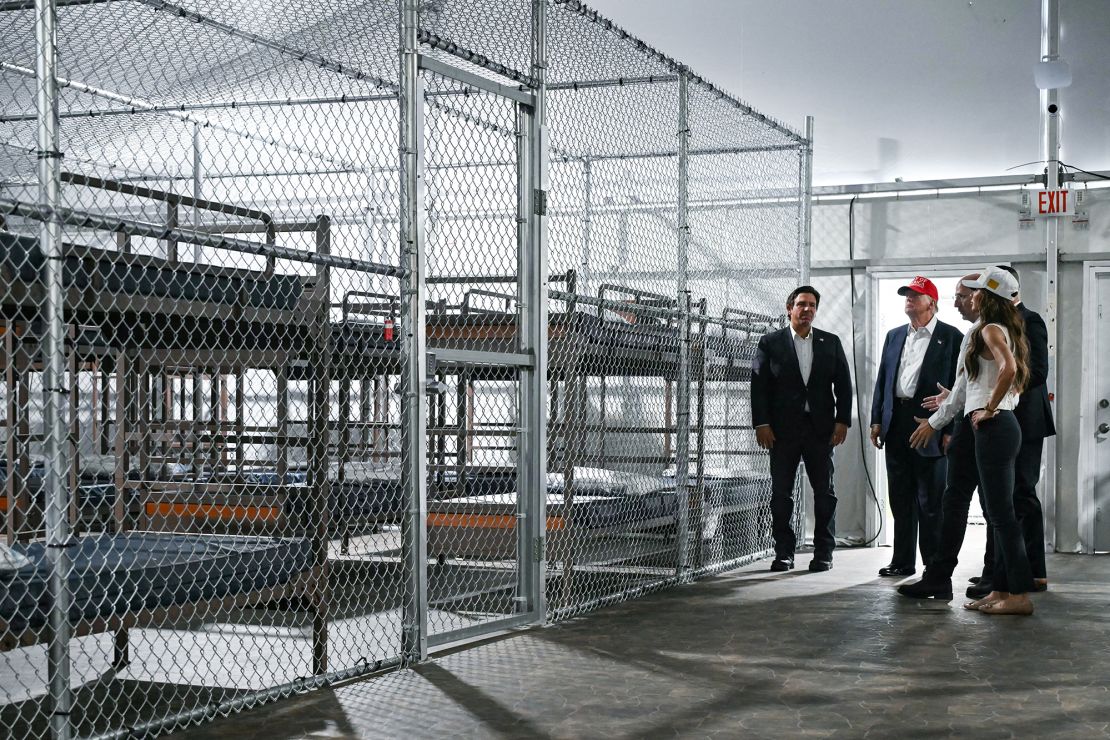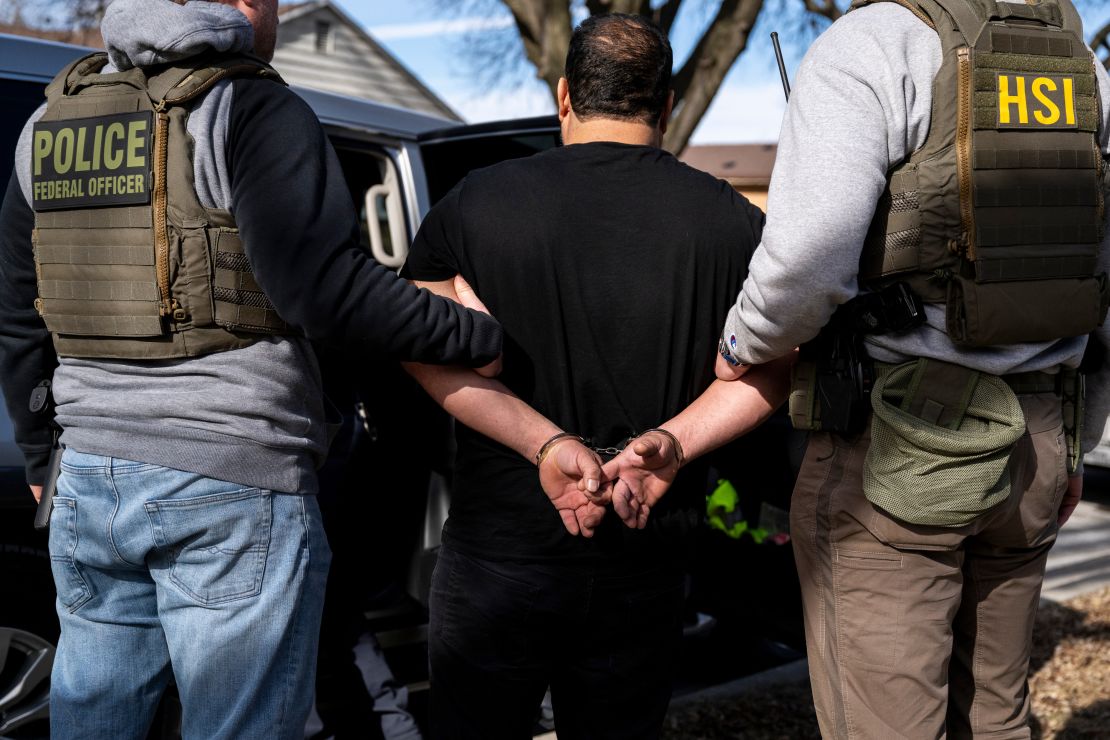CNN
—
The Trump administration is preparing for a historic infusion of cash into the president’s sweeping mass deportation campaign that is expected to supercharge immigration enforcement nationwide — and likely place additional pressure on the already-overwhelmed federal agency at the center of it all.
Since receiving its mass deportation edict after President Donald Trump took office in January, Immigration and Customs Enforcement has fielded criticism from people inside the administration who think they aren’t doing enough, lawmakers and advocates who think they are doing too much, and an incensed public that in some cases is taking drastic action to impede immigration enforcement.
Trump and Homeland Security Secretary Kristi Noem have repeatedly touted the work of ICE and the agents on the ground making immigration arrests. “These are strong people — tough people — that love our country,” Trump said at the White House on Wednesday. “If they weren’t tough, they wouldn’t survive.”
While the public messaging from the president and DHS leadership has been positive, the reality for officers is far more complicated, involving tense calls with the White House daily and working around the clock amid public backlash.
ICE, a Homeland Security official told CNN, “keeps getting kicked in the teeth.”
Now, ICE is set to receive $75 billion in funding from the president’s sweeping agenda bill for detention expansion and enforcement and removal operations, including hiring new agents. It’s an unprecedented amount of cash for an agency that’s historically been underfunded, and Trump administration officials are preparing to make the most of it.
“We’re going to come harder and faster, and we’re going to take these criminals down with even more strength than we ever have before,” Noem said this month, describing how the infusion of cash will bolster her agency’s immigration-enforcement apparatus.
Expanding detention
ICE is charged with arresting and detaining immigrants in the United States. For years, current and former officials say, it has struggled with limited federal funds and personnel.
In multiple interagency discussions, senior Trump administration officials have been drafting plans to hire thousands more agents and drastically expand immigrant detention. White House border czar Tom Homan told CNN he’s been in regular calls with ICE and US Customs and Border Protection to check on progress with contracts, though he’s largely recused himself from the process given previous work, and he’s in discussions over how to bring on thousands more officers and bolster the academy where they’re trained.

But top of mind is bringing online thousands more detention beds to keep pace with arrests.
“I think we’ll have 100,000 beds by the end of the year. That’s a priority,” Homan said. ICE was previously funded for around 41,000 beds. Homan said some of the new beds would be in permanent buildings, and others in temporary structures like tents.
The cash comes at a critical time for ICE, which was maxed out on detention space and was grappling with fewer than 200 available beds on a daily basis, according to Homan. Around 57,000 people are currently in ICE custody, according to federal data obtained by CNN.
The increase in detention has been fueled by an uptick in arrests. But numbers have still not met the goal of 3,000 daily arrests set by Stephen Miller, the architect of Trump’s immigration policy; instead, fluctuating between 1,000 and 2,000 arrests a day, the data shows. Deportations also continue to lag, not yet outpacing the Obama administration, which was able to quickly remove recent border crossers.
The pressure to pivot to immigration enforcement has also extended to components of DHS that have not typically been responsible for arresting immigrants in the interior, including the Homeland Security Investigations arm, which focuses on a wide range of criminal activity, including human trafficking and cybercrime, among other threats to national security.
Homan recognized the tension among federal agencies over the prioritization of immigration enforcement and within the ICE workforce over the daily arrest quotas.
“It depends on who you talk to. The quotas are very doable. But I’ve heard that other agencies want to get back to their mission whenever we bring more people on board, hire more immigration people,” he said. “Some people like quotas, some don’t, but we all work within the framework provided by the administration.”
When Trump signed his agenda bill into law, it set up ICE to be the most well-funded police force in the federal government over the next four years.
“They have now the blank check to do all these things,” a former Homeland Security official told CNN.
ICE alone is set to receive nearly $75 billion through 2029, including about $45 billion that is being set aside specifically to increase capacity at immigration detention centers. The other nearly $30 billion is going toward enforcement and removal — a cash windfall that will be directed toward the front-line ICE operations that involve arresting immigrants and transporting them to detention centers.

The agency has long been criticized for some of its practices, but that has intensified this year along with the new arrest quotas, souring the mood among agents tasked with executing the president’s controversial immigration agenda.
“There’s a lot of brain drain going on,” a former Homeland Security official told CNN. “Every single day they have people out on the field, holidays, weekends be damned. They’re expected to have people every day.”
The administration plans to make a big push toward recruiting, bringing people back who have retired, hiring from other law enforcement agencies, and increasing the capability of the academy where agents train more quickly. Messages have already gone out to retired ICE officers, asking that they return and offering financial incentives such as bonuses.
“You served the United States of America with distinction and honor,” reads an email addressed to former ICE officials from Deputy Director Madison Sheahan and obtained by CNN. “Now, your country calls upon you to serve once more.”
The administration is trying to determine how many classes it can put through the ICE academy at the Federal Law Enforcement Training Centers in Georgia by the end of the year. Hiring and training is typically a monthslong process.
“As we continue hiring, we’ll have classes ready to go. We’ll have people in place ready to attend classes. Recruiting, hiring, No. 1, get the academies as quickly as can, and throw those people we’ve hired through the academy,” Homan said. “It’s really important they have a larger footprint.”
Tens of billions of additional dollars will flow into other aspects of Trump’s immigration agenda. More than $46 billion will be funneled toward the construction and maintenance of border barriers, helping Trump to fulfill a promise he made when he mounted his first presidential campaign a decade ago.
“There are all kinds of plans when we have more money,” the Homeland Security official said. “It’s honestly more boots on the ground to do enforcement. It’s going to be more detention space.”
As ICE detentions rise, the Trump administration has put in place a series of policies that have drastically curtailed opportunities for migrants to be released and paved the way for people to be swiftly deported to countries that are not their own.
While the administration has said it’s going after the “worst of the worst,” federal data reveals that the majority of immigrants taken into custody don’t have serious criminal convictions. The White House and Department of Homeland Security maintain that those being targeted for arrest are public safety and national security threats.
That’s contributed to growing alarm among immigrant advocates and attorneys, especially on the heels of new guidance that will largely prevent people who are brought into ICE custody from being released.
In a recent memo, the acting director of ICE told agents that immigrants who arrived in the US illegally going back decades were no longer eligible for a bond hearing while they fight their deportations in immigration court.
In other words, those previously allowed to remain out on bond as their case made its way through the immigration system, which can take years, now could be taken into custody and spend months in detention.
“The Trump administration is doing a complete end-run around our court system with DHS now telling immigration judges what powers they have and what they don’t have — most recently with the July 8 DHS memo that strips judges of the power they’ve exercised for decades to decide whether a person should be detained,” said Gregory Chen, senior director of government relations for the American Immigration Lawyers Association.
Legal orientation programs in detention facilities have also largely been dismantled after the federal government cut funding for those programs, leaving immigrants in detention with little to no resources to navigate the arduous immigration system in the moments before they’re deported.
“It’s a coin toss now. It used to be if you had no criminal history, you had some ties, you had connections here, more often or not you had bond and that’s because we lacked the bed space to keep people detained,” another former Homeland Security official told CNN.
Now that there’s more bed space, the official added, “there’s no reason for ICE to want to get people released.”
‘Escalate and escalate and escalate’
ICE has made a visible push to deploy officers nationwide and carry out sweeps in places that have generally been off-limits, like courthouses.
The agency has also stepped up raids on farms and places where day laborers congregate, like Home Depot parking lots. Those tactics have fueled tension among Republicans, some of whom have expressed concern over enforcement actions on industries where immigrants remain a vital source of labor.

“We can’t take farmers and take all their people and send them back because they don’t have maybe what they’re supposed to have — maybe not,” Trump said during a June news conference, acknowledging that tension.
Democratic elected officials have also criticized the agency’s tactics as heavy-handed and reminiscent of some of the darkest moments in modern history.
Minnesota Gov. Tim Walz has described ICE under Trump as a “modern-day Gestapo.” Los Angeles Mayor Karen Bass said the agency’s immigration sweeps in her city last month — the catalyst for days of protests — left her “deeply angered.” California Sen. Alex Padilla said the administration’s push for higher arrest and deportation numbers is making the agency and its employees “more aggressive, more cruel [and] more extreme.”
“Any violence against law enforcement is unacceptable,” Padilla said on CNN earlier this month. “Do I think heated rhetoric is part of what’s causing this response? Sadly, yes, and we’ve seen this administration escalate and escalate and escalate.”
Last month, Padilla was forced to the ground and briefly handcuffed after interrupting Noem during a press conference amid tensions in Los Angeles over the administration’s crackdown.
In New Jersey, Rep. LaMonica McIver, a Democrat, has been indicted on charges of assaulting and impeding law enforcement stemming from a clash outside of a Newark detention facility that also led to the arrest of the city’s mayor, Ras Baraka. Baraka’s charges were later dropped; McIver, who has pleaded not guilty, is scheduled to face trial in November.
The third prong of pressure has come from citizens who, in some cases, are adopting increasingly militant postures to oppose ICE and the administration’s enforcement actions.
In some instances, which have been widely publicized by the administration, people have pelted federal law enforcement or their vehicles with rocks, bricks and other solid objects.
In at least three incidents, federal immigration law enforcement has been met with gunfire: On July 4, an officer was shot during an alleged attack on an ICE detention facility in Texas. Days later, a gunman was killed after opening fire on a Customs and Border Protection facility in Texas, injuring one officer.
And on July 10, federal officers conducting enforcement on a marijuana farm in California were met with gunfire, though nobody was injured.
These incidents have incensed Trump. “I am giving Total Authorization for ICE to protect itself,” he said in a July 11 social media post, “just like they protect the Public.”
CNN’s Josh Campbell contributed to this report.

